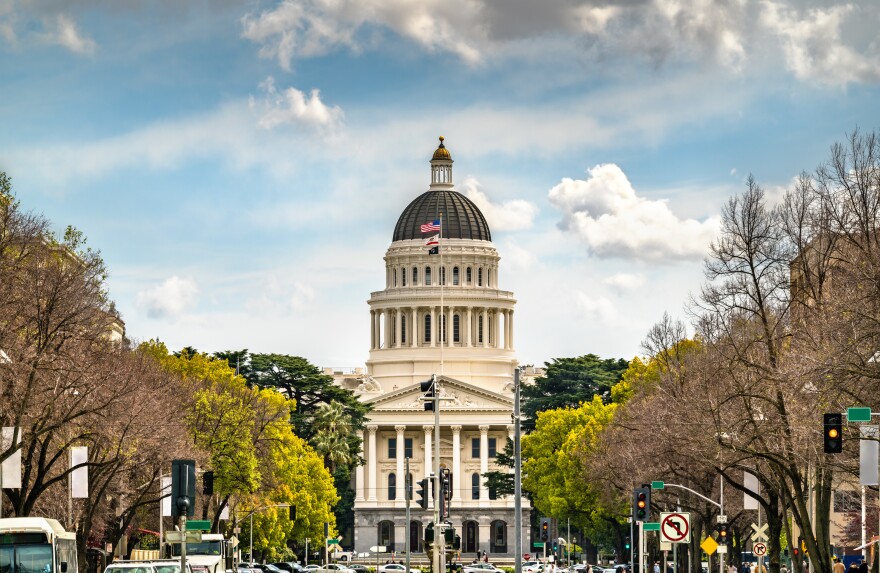CapRadio state politics reporter Nicole Nixon has been following the race to fill a congressional seat in a new, sprawling district that borders Nevada. According to the Cook Political Report, it leans “Likely Republican.” But top GOP candidates split the majority of votes, so one of them will face Democrat Kermit Jones in the general election.
Nixon sat down with KUNR’s Bert Johnson to talk about the results – and other important races in California’s primary election.
Bert Johnson: What can you tell us about the preliminary results in Congressional District 3?
Nicole Nixon: This is a district that spans the Nevada border for several hundred miles, and preliminary results show that Democrat Kermit Jones will face off against Republican Kevin Kiley in November. Jones is a Roseville physician [and a] Navy vet, and Kylie is a Republican state lawmaker who’s been a very vocal critic of the Gavin Newsom administration here in California. [He] ran to replace the governor in the recall last year, but that was obviously unsuccessful. So he has continued in the legislature and [is] hoping to make it to Congress.
Johnson: Like you just mentioned, this is a pretty big district, but it’s also a new district; the lines were just drawn in the most recent redistricting process. Just like a lot of the new districts here in Nevada, of course, that happens every 10 years. But what does this district look like?
Nixon: It’s a really interesting district. Like I said, it’s huge; it starts way north of Lake Tahoe, near Lassen Volcanic National Park, and goes into these sort of bedroom community suburbs near Sacramento and sweeps all the way down along the border into Death Valley. So a lot of different constituents – very rural, very urban, suburban – and a lot of different issues for the candidates to try to represent. You know, trying to represent everyone in this district, I think will be a challenge no matter who wins.
Johnson: In the last month, two large mass shootings killed dozens of people and made the issue of gun safety a top priority for many people in the U.S. Now Congress is weighing a ban on so-called ghost guns, which are untraceable, and a national Red Flag Law that would make it possible to temporarily remove guns from people who pose a danger to others or themselves. Where do the candidates in Congressional District 3 stand on gun issues?
Nixon: You know, we had a debate with the three leading candidates about a week before the election, and guns came up, but I framed the question as more of, “Why do mass shootings happen in the U.S. more than any other, you know, developed country?” And candidates actually did not talk about gun control when they answered that question. They talked instead about things like school safety and a youth mental health crisis.
Johnson: So Nicole, another district in California that sits on the border between California and Nevada is state Senate District 4. That includes Lake Tahoe and some of the communities around there. What can you tell us about the preliminary results from the primary in that district?
Nixon: Bert, this was such an interesting primary because it’s kind of a new, open seat. There wasn’t an incumbent state lawmaker running here. And it’s a Republican-leaning district, you know, it covers the Sierra Nevada, reaches down into Modesto, Turlock area. But there were so many Republicans running in this race – six Republicans – that they kind of split that GOP vote. And the top two vote-getters right now are both Democrats. So it looks like in this Republican-leaning district, there will be two Democrats on the general election ballot: Marie Alvarado-Gil and Tim Robertson.
Johnson: And just as a note of explanation for our listeners in Nevada: That’s because of the way that the California primary structure works, where the top two vote-getting candidates, as you just explained, are the ones who will move forward, rather than the top vote-getter from each party. And so on to our final question. Top of the ballot in California were, of course, the gubernatorial primaries; Governor Gavin Newsom was running against a slate of challengers. And there was also the attorney general’s race. What can you tell us about some of the preliminary results there?
Nixon: Yeah, so it looks like the Democratic incumbents in these two statewide offices did really well. Gavin Newsom and Attorney General Rob Bonta both have well over 50% of the vote. They will still go to a general election, though. Both will face Republican candidates. Newsom will face a state senator named Brian Dahle. He’s a farmer from the [northern] part of the state and a Republican. And then Rob Bonta, it’s not totally clear who his opponent will be. There are two Republican attorneys kind of vying for that second place right now, and there are still a lot of votes to count. So, not exactly clear who that challenger will be in November, but Bonta will face a Republican.
Produced with assistance from the Public Media Journalists Association Editor Corps funded by the Corporation for Public Broadcasting, a private corporation funded by the American people.






